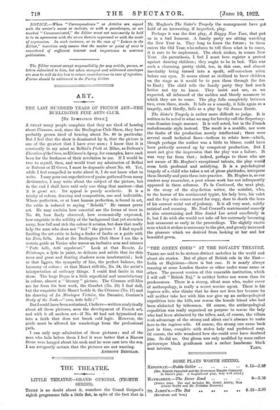ART.
THE LAST HUNDRED YEARS OF FRENCH ART THE BURLINGTON FINE ARTS CLUB.
[BY INVITATION ONLY.]
A GREAT many people complain that they are tired of hearing about Cezanne, and, since the Burlington Club Show, they have probably grown tired of hearing about No. 40 in particular. But I feel that the show is dominated by it, that the picture is one of the greatest that I have ever seen ; I know that it is constantly in my mind as Bellini's Pieta at Milan, as Rubens's Elevation of the Cross, asEl Greco's Agony, for examples, have each been for the freshness of their revelation to me. If I would be true to myself, then, and would trust my admiration of Bellini or Rubens or El Greco, I must be dogmatic about No. 40. Yet, while I feel compelled to write about it, I do not know what to write. I may pour out superlatives of praise gathered from many dictionaries, I may write about the subject of the picture, but in the end I shall have said only one thing that matters—that it is great art. Its appeal is purely aesthetic. It is a trinity of colour, drawing and composition, one and indivisible. Where perfection, or at least human perfection, is found in art, the critic is reduced to saying " Behold." He cannot prove art. He may exclaim how essential are the forms of trees in No. 40, how finely observed, how economically expressed, how exquisite is the solidity of the background that yet stretches away, how full and rich the colour it retains, but does that really help the man who does not " feel " the picture ? I find myself limiting the art critic to being a finder of faults or a guide with his Ecco, bells. And at the Burlington Club Show I am like a certain guide at Venice who waves an inclusive arm and intones " Tutte belle, tutu capolavori." Look at that Renoir, Le Printemps, a lyric in paint, so delicate and subtle that its thin trees and grass and floating shadows seem insubstantial ; look at that kgres, the sympathy of line, the perfect balance, the harmony of colour ; at that Menet still-life, No. 24, the artist's interpretation of ordinary things. I could find faults in this show. The large Degas is a little superficial and unsatisfactory in colour, almost a " literary " picture. The Cezanne still-lifes are far from his best work, the Courbet (No. 28) I find dull, but the exquisite little Manet beside it, the Cezanne (No. 17) and his drawing of La _Montagne Victoire, the Daumier, Couture's Study of the Nude—" ecco, tutle belle 1 " But I could have been restrained, I believe—written analytically about all these pictures, seen the development of French art, and with it all modern art—if No. 40 had not hypnotized me into a faith that does not brook cold logic. However, the guide must be allowed his wanderings from the professional path.
I can only urge admiration of these pictures : and of the man who fails before them I feel it were better that .a Marcus Stone were hanged about his neck and he were cast into the sea. I am arrogantly certain that the pictures are not wanting.
ANTHONY BERTRAM.


































 Previous page
Previous page